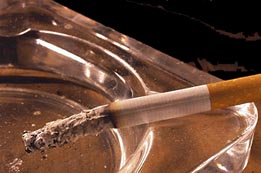

Our
mission is to reduce the number of injuries and deaths due to
injuries,
through prevention, improved trauma care, and improved rehabilitation.
The tragic scenario begins when a smoker
inadvertently drops a lit cigarette on bedding or on the cushions of an
overstuffed sofa or chair. The smoker is often intoxicated or sleeping. The
misplaced cigarette continues to burn even though it is not being puffed.
After a few minutes, the cigarette initiates the smoldering of the
upholstery or mattress. Within the next hour, smoke is produced and within
the next two hours, the furniture or bedding bursts into flames.
--DeFrancesco, Teret, McGuire, "Liability for cigarette-related fire
death and injury." Trial Lawyers Quarterly
August
25, 2003
Update on the Fire-Safe
Cigarette– How New York State Legislation Will Lead to the Availability of Fire-Safe
Cigarettes Across the Nation
 Cigarette-ignited fires are the leading cause of fire deaths in the United States. Approximately 1000 children, adults, and elders are killed annually due to cigarette-ignited fires and an additional 3,000 are burn injured.
Cigarette-ignited fires are the leading cause of fire deaths in the United States. Approximately 1000 children, adults, and elders are killed annually due to cigarette-ignited fires and an additional 3,000 are burn injured.
Because the Consumer Product Safety Commission (CPSC) can regulate fabric and furniture standards, but not cigarettes, injury prevention advocates have been forced to take their demands for safety from cigarette-ignited fires to the state and federal legislatures. As reported on this web page before, the tobacco industry has long known how to create a cigarette that will not ignite bedding or furnishings, causing deadly fires. However, fearing the admission of culpability and litigation, the powerful tobacco industry and its lobbyists have been largely reluctant to produce such cigarettes and to let state and federal legislatures impose standards on their deadly but profitable products.
The tobacco industry, as indicated in some cigarette manufacturer documents, is keen to rearticulate the debate and focus not on the data that show the causes of fire death, but on redirecting attention for a demand that the CPSC better regulate
furniture and fabrics. For example, in one of R.J.Reynold's (RJR) documents available for viewing at
UCSF's Tobacco Documents Library, the company states one of its strategies in this way: "continue to encourage regulatory attention to the smolder-resistance of upholstered furniture and mattresses" and RJR goes on to say that one of its chief strategic objectives is that there will be "no fire-related federal, state or local
regulatory authority over cigarettes or smokers involved in fires." [Tobacco
Documents Library document number: 522573948/3952]
First New York, Then the Nation
The year 2000, though, saw two groundbreaking events: New York State passed the nation’s first law requiring the establishment of a fire safety standard for cigarettes sold in the state that was due to take effect July 1, 2003, and Philip Morris began the mass production of a cigarette (its Merit brand) that is significantly less likely than conventional cigarettes to ignite furniture or bedding.
In New York, the proposed safety standard recently underwent a period of comment from advocates and the tobacco industry. Advocates are now awaiting the New York Secretary of State’s promulgation of the standard, which, once promulgated, will take effect within 180 days. The Trauma Foundation believes as it has for the last 25 years, that once the tobacco industry is required to create a fire-safe cigarette in order to do business in a state
such as New York, these fire-safe cigarettes will become available across the nation. In turn, this
probably will result in a substantial drop in deaths from cigarette-ignited fires.
And then, as sometimes happens, the interests of public health will triumph over
corporate executives who knowingly engage in murder.
Useful Links:
Search UCSF's Tobacco Documents Library
http://legacy.library.ucsf.edu/
New York Assemblyman
Alexander Grannis (D-NY)
phone: 518-455-5676
email: grannis@assembly.state.ny.us
 |
 |
|---|